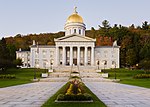Wrightsville Reservoir
Bodies of water of Washington County, VermontDams in VermontEast Montpelier, VermontMiddlesex, VermontMontpelier, Vermont ... and 4 more
Reservoirs in VermontTourist attractions in Washington County, VermontUse American English from July 2023Use mdy dates from July 2023
Wrightsville Reservoir is a reservoir located in Washington County, Vermont, United States, as a result of the construction of the Wrightsville Dam built from 1933 to 1935 after the Great Flood of 1927. It is located at the intersection of the municipal borders of three towns, Montpelier, Middlesex, and East Montpelier. It is a popular recreational spot in the summer, for swimming, boating, and fishing in the Montpelier area. During the July 2023 Northeastern United States floods, floodwaters reached the second highest recorded Winooski River level and threatened to spill the dam, but receded on the third day.
Excerpt from the Wikipedia article Wrightsville Reservoir (License: CC BY-SA 3.0, Authors).Wrightsville Reservoir
Vermont Route 12,
Geographical coordinates (GPS) Address Nearby Places Show on map
Geographical coordinates (GPS)
| Latitude | Longitude |
|---|---|
| N 44.316666666667 ° | E -72.575 ° |
Address
Vermont Route 12
Vermont Route 12
Vermont, United States
Open on Google Maps





